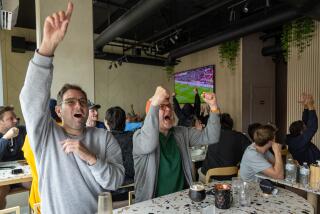Culture Kick : Soccer: Each Sunday at Balboa Park, teams of different nationalities compete in a dozen simultaneous matches.
ENCINO — It’s a place where English is a second language and soccer is the name of the game.
Men forge their way onto the dewy grass, stretching their tight muscles and talking strategy. Bleary-eyed kids pile out of the family car looking for shade and the guy who sells candy. Wives, mothers or girlfriends tag along, lugging coolers heavy with food and drink, lawn chairs and baby carriages.
Then, promptly at 8 a.m. each Sunday, the action begins with the sharp trill of a whistle and Balboa Park becomes overrun with a dozen, simultaneous soccer matches.
Over on the south side of the park are the Mexicans. Cubans, Bolivians and Peruvians mingle on teams in the center fields. Next to them are the Brazilians, Argentines and Middle Easterners. And the Italians, Hungarians, Romanians, Israelis and English can be found near the rear of the park.
“The good thing about this park is that the teams are divided into cultures,” said Guy Moskowitz, a 30-year-old father on the Israeli team, who took his two young sons to watch him play recently. “Everyone knows who is on what team.”
That’s because each team has its own idiosyncrasies.
Players from Mexico genuflect, making the sign of the cross, before each starting whistle and after each goal. The Italians rough it, wearing little leg protection, and are known for viewing pushing and shoving as part of the game. The Hungarians hold onto older players--the eldest frequenting the park is 65--to draw from their experience.
One recent Sunday, Hungarian Coach Joe Hirschpold yelled wildly in Hungarian at his players, explaining later that it gives them the encouragement they need to focus on the game.
“There are just different styles of playing soccer,” Hirschpold said as he caught his breath between commands. “But you adjust your team and try to stay away from playing rough.”
Practically bellowing in his native tongue, he urged his players to anticipate the Italians’ pushing and maneuver themselves away. They obeyed, their faces red with effort.
A few college-age men make up the youngest team. With their bright yellow jerseys, boyish faces and contrasting hair colors, the members are known as the “melting-pot team,” because they come from Japan, Scotland and Barbados as well as all over the United States.
“But the downside with us is we haven’t won a game in a while,” said California native Brian Pena, shrugging his shoulders. “So I don’t know if the multicultural thing works for us.”
Balboa Park is filled with men most weekends, but women’s soccer has appeared in a somewhat unusual form.
At the northeast corner of the park, a group of women are playing in their first soccer tournament organized--and coached--by their boyfriends. It isn’t a completely serious tournament, they say, but nonetheless competitive.
Their brightly made-up faces are flushed from running up and down the field, which is smaller than a normal field. Their gold and silver earrings flail in the wind and they tend to adjust their shorts a lot.
A three-week tournament dubbed ferroviario --literally meaning railroad workers, and a popular name for soccer teams in Bolivia--has four female teams made up of first- and second-generation Bolivians, with a sprinkling of Peruvians.
So as not to tire them, their boyfriends decided to apply the dimensions of an indoor soccer field for their outdoor tournament.
“The game is not rough,” insisted Giovannina Chacon, pushing her gelled short hair over her ears. “It is mostly just for fun.”
An instant later, Chacon had jumped to her feet and was waving her arms and shouting fiercely: “Get the ball!”
At the awards ceremony that ended the tourney, the women stood around a table filled with gleaming trophies and a diablada , or devil’s mask used in Bolivian indigenous dances.
“The women are real fighters,” referee Ramiro Vargas said. “They don’t agree with any call.”
Yet for all the competition and different cultures at the park, there are many commonalities, especially among the children.
There is no telling which country the players’ ancestors came from as they arrive at the park with fathers, uncles, cousins or brothers. Once their feet hit the grass, they all look the same playing in the puddles, kicking an errant soccer ball or watching the games.
And no matter what language they speak at home, they are all familiar with the words “hot dog” and “candy.”
“We like to watch my dad play, but sometimes he makes us come to the park with him because my mom wants to do something else,” complained 11-year-old Ricardo Espinoza, who happily breakfasted on candy with sister Elizabeth, 9, and Jose, 7, as father played.
The players, meanwhile, rationalize why they drag their kids to the park.
“They learn the game by watching us,” said Roni Yosef, motioning to his 9-year-old daughter, Cassidy, whom he has brought to the park since she was an infant.
“They are the next generation to play.”
More to Read
Sign up for Essential California
The most important California stories and recommendations in your inbox every morning.
You may occasionally receive promotional content from the Los Angeles Times.










